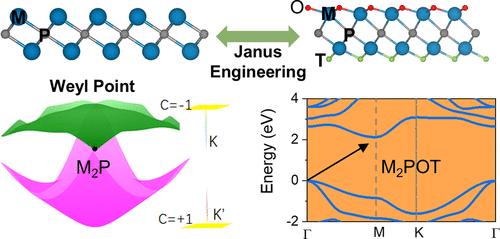二维稀土金属磷化物:从Weyl半金属到半导体
IF 8.2
2区 材料科学
Q1 MATERIALS SCIENCE, MULTIDISCIPLINARY
引用次数: 0
摘要
二维(2D)纳米材料因其独特的性能和广泛的应用而受到广泛关注。本文在密度泛函理论模拟的基础上,研究了一类二维稀土金属磷化物(M2P, M = Sc, Y, La)及其衍生物M2POT (T = F, OH)的拓扑和电子性质。我们发现二维M2P化合物很可能是由热力学稳定的M2InP通过化学剥离得到的。原子半径为156 pm的In表现出较弱的极化能力,导致电子云的均匀性和M-In键相对于M-P键的减弱。In层剥离后,M22+P3 -:e -以具有表面电子的电极形式出现,这是由于M2P中M2+离子的离子半径较大,电负性较低。发现金属M2P是一种由表面电子贡献的Weyl半金属。此外,利用表面电子的高反应性,表面功能化可以产生具有M3+价态增加的M2POT化合物,从而使其具有高载流子迁移率和强内置电场的半导体性质。这些独特的拓扑和电子特性使2D M2P和M2POT成为广泛应用的有希望的候选者。本文章由计算机程序翻译,如有差异,请以英文原文为准。

Two-Dimensional Rare-Earth Metal Phosphides: From Weyl Semimetal to Semiconductor
Two-dimensional (2D) nanomaterials have garnered extensive attention owing to their unique properties and versatile application. Here, a family of 2D rare-earth metal phosphides (M2P, M = Sc, Y, La) and their derivatives M2POT (T = F, OH) is developed to find their topological and electronic properties on the basis of density functional theory simulations. We show that the 2D M2P compounds are most possibly obtained from thermodynamically stable M2InP by chemical exfoliation. The In with a substantial atomic radius of 156 pm exhibits weak polarization ability, resulting in homogeneity of the electron cloud and a weakening of the M-In bond relative to the M-P bond. Upon exfoliation of the In layer, the M22+P3–:e– emerges as an electride with surface electrons, which is attributed to the larger ion radius and lower electronegativity of M2+ ions in M2P. The metallic M2P is found to be a Weyl semimetal derived from the contribution of surface electrons. Further, by leveraging the high reactivity of surface electrons, surface functionalization can produce M2POT compounds with the increased valence state of M3+, which results in their semiconducting properties characterized by high carrier mobilities and strong built-in electronic fields. These distinct topological and electronic characteristics position the 2D M2P and M2POT as promising candidates for a wide range of applications.
求助全文
通过发布文献求助,成功后即可免费获取论文全文。
去求助
来源期刊

ACS Applied Materials & Interfaces
工程技术-材料科学:综合
CiteScore
16.00
自引率
6.30%
发文量
4978
审稿时长
1.8 months
期刊介绍:
ACS Applied Materials & Interfaces is a leading interdisciplinary journal that brings together chemists, engineers, physicists, and biologists to explore the development and utilization of newly-discovered materials and interfacial processes for specific applications. Our journal has experienced remarkable growth since its establishment in 2009, both in terms of the number of articles published and the impact of the research showcased. We are proud to foster a truly global community, with the majority of published articles originating from outside the United States, reflecting the rapid growth of applied research worldwide.
 求助内容:
求助内容: 应助结果提醒方式:
应助结果提醒方式:


